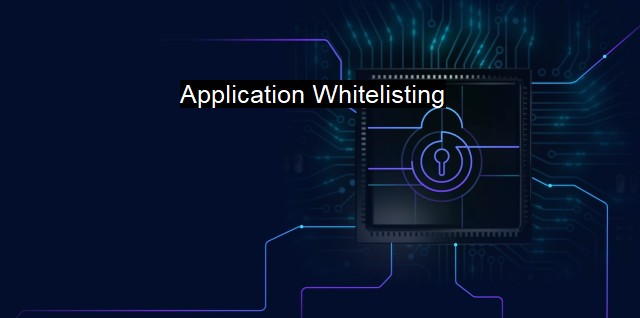What is Application Whitelisting?
The Importance of Application Whitelisting in Cybersecurity: Protecting Computer Systems from Advanced and Persistent Threats
Application whitelisting is a critical strategy which provides an additional layer of protection to a computer system. Think of it as a nightclub's exclusive list, allowing well-known, verified guests only. Any entity not on the whitelist would be an unwelcome visitor, denied entry. Extending the analogy to the cybersecurity world, application whitelisting refers to an approach where only specified software applications are allowed to execute on a system, while all others (not in the whitelisted category) are blocked by default.This proactive approach has stirred tremendous interest in the world of cybersecurity and antivirus protection. Traditional antivirus (AV) software generally operates on a system of blacklisting, where malicious programs, known as malware, are catalogued and protocols are established to detect and remove them. the cybersecurity landscape significantly evolves with time, and new forms of viruses are continually cropping up, which makes it increasingly challenging for blacklisting cultures to stay ahead of the curve. This is where application whitelisting comes in.
Application whitelisting works on a completely different premise – it emphatically says ‘No’ to any such anomalies. In application whitelisting, the focus shifts from identifying what is harmful to giving access solely to the well-known, i.e., safe entities. Hence, even if there are unidentified malicious programs or unaccounted risks, they can't harm the systems since they're inherently blocked from execution.
The application whitelisting process involves creating an inventory of approved applications that are allowed on the network. Some applications deemed mandatory for the fundamental operations might include operating system files, authorized software platforms, system applications, or even required plugins. Every new application execution request is compared against this inventory and if a match is found, the execution is allowed otherwise, it is blocked.
The inherent benefit of application whitelisting is the significantly improved malware protection when compared to traditional virus-filtering based protection methods. Leveraging this strategy gives enterprises the proactive power to mitigate the potential risk of malware infiltration, therefore ramping up their cybersecurity robustness.
This presents a particularly useful solution in business settings where the IT infrastructure might comprise of hundreds of systems with different software requirement hierarchies. Employing an application whitelisting mechanism ensures that only the required software executes in the entire IT ecosystem, minimizing the attack vector and surface.
Despite the apparent advantages, implementing application whitelisting is not without challenges. It typically requires considerable administrative oversight, meticulous selection and regular updating of the whitelist considering the dynamic nature of cybersecurity threats. the whitelisting process could potentially become too rigid, therefore accidentally blocking beneficiary software updates or patches.
Conflict resolutions can also surface, especially when a much-needed application is irrationally blocked due to its absence in the whitelist. Hence, a balance is needed. Inappropriate over-control can inadvertently disable important functionalities needed for business operations.
Leveraging application whitelisting as part of a more comprehensive cybersecurity strategy could offer unparalleled protection. As the threat landscape continues to evolve, application whitelisting provides a proactive barrier to infiltration. it should be implemented wisely and cautiously, acknowledging both the expanding range of cyber threats and the constant evolution in business software needs.
Application whitelisting practices, when implemented and maintained correctly, can allow more effective regulation of applications, reduced process disruption and better response to real threats. With the proper adaption and execution, application whitelisting could become an indispensable part of tomorrow's cybersecurity implementations. The potential benefits, from additional protection to mitigated risk, make application whitelisting worth considering for any serious-spirited cybersecurity initiative.

Application Whitelisting FAQs
What is application whitelisting?
Application whitelisting is a cybersecurity approach that restricts the execution of software applications to a pre-approved list of applications. This approach helps to prevent the execution of malicious code by unauthorized applications, reducing the risk of malware infections.How does application whitelisting differ from antivirus?
Antivirus software scans for known malware and suspicious behavior patterns to detect and block malicious software. In contrast, application whitelisting relies on a whitelist of approved applications and only allows them to run on a system. Antivirus software is reactive in nature, while application whitelisting is proactive.What are the benefits of application whitelisting?
Application whitelisting offers several benefits, including better protection against malware and other cyberthreats, improved system performance as only approved applications are allowed to run, and reduced attack surface by restricting the execution of unauthorized applications. It can also help organizations meet compliance requirements by providing a more secure computing environment.What are the challenges of implementing and maintaining application whitelisting?
Implementing and maintaining application whitelisting can be complex and time-consuming, especially in large organizations with a wide range of software applications. Identifying all authorized applications and updating the whitelist as needed can be challenging. Also, application whitelisting can limit user flexibility and may not be suitable for all types of environments or use cases.| | A | | | B | | | C | | | D | | | E | | | F | | | G | | | H | | | I | | | J | | | K | | | L | | | M | |
| | N | | | O | | | P | | | Q | | | R | | | S | | | T | | | U | | | V | | | W | | | X | | | Y | | | Z | |
| | 1 | | | 2 | | | 3 | | | 4 | | | 7 | | | 8 | | |||||||